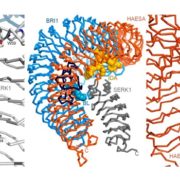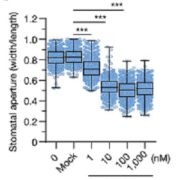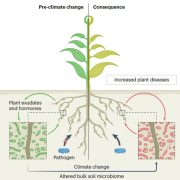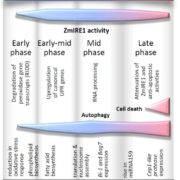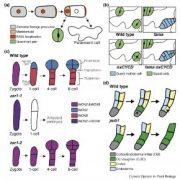Symplastic coordination of root nodule development (Curr. Biol.)
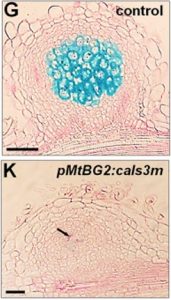 The establishment of root nodule symbiosis in legume roots involves the perception, infection, and accommodation of nitrogen-fixing rhizobia. The de novo formation of root nodules relies on complex developmental programs coordinated through different tissues via unknown cellular routes. Gaudioso-Pedraza et al. investigated the importance of plasmodesmatal cell-cell junctions (PD) for the initiation of root nodule development/symbiosis in the model legume Medicago truncatula. The authors identified a rhizobacteria-induced beta-1,3-glucanase (MtBG2) that is located at plasmodesmata, and whose upregulation coincides with a reduction in callose; a beta-1,3-glucan with known roles in plasmodesmatal regulation. MtBG2 overexpression promoted root nodule development and the cell-to-cell movement of soluble YFP from the epidermis to the cortex, supporting the idea that MtBG2 regulates plasmodesmatal conductance to promote signal movement and organogenesis in the cortex. Consistent with this idea, inducible expression of a hyperactive PD-occluding callose synthase variant (cals3m) driven by the MtBG2 promoter negatively impacted nodule development and the symbiotic accommodation of rhizobacteria. Collectively, these data identify plasmodesmata and MtBG2 as critical gatekeepers of signals that travel between cell layers to initiate root nodule organogenesis and symbiosis. (Summary by Phil Carella) Curr. Biol. 10.1016/j.cub.2018.09.031
The establishment of root nodule symbiosis in legume roots involves the perception, infection, and accommodation of nitrogen-fixing rhizobia. The de novo formation of root nodules relies on complex developmental programs coordinated through different tissues via unknown cellular routes. Gaudioso-Pedraza et al. investigated the importance of plasmodesmatal cell-cell junctions (PD) for the initiation of root nodule development/symbiosis in the model legume Medicago truncatula. The authors identified a rhizobacteria-induced beta-1,3-glucanase (MtBG2) that is located at plasmodesmata, and whose upregulation coincides with a reduction in callose; a beta-1,3-glucan with known roles in plasmodesmatal regulation. MtBG2 overexpression promoted root nodule development and the cell-to-cell movement of soluble YFP from the epidermis to the cortex, supporting the idea that MtBG2 regulates plasmodesmatal conductance to promote signal movement and organogenesis in the cortex. Consistent with this idea, inducible expression of a hyperactive PD-occluding callose synthase variant (cals3m) driven by the MtBG2 promoter negatively impacted nodule development and the symbiotic accommodation of rhizobacteria. Collectively, these data identify plasmodesmata and MtBG2 as critical gatekeepers of signals that travel between cell layers to initiate root nodule organogenesis and symbiosis. (Summary by Phil Carella) Curr. Biol. 10.1016/j.cub.2018.09.031


